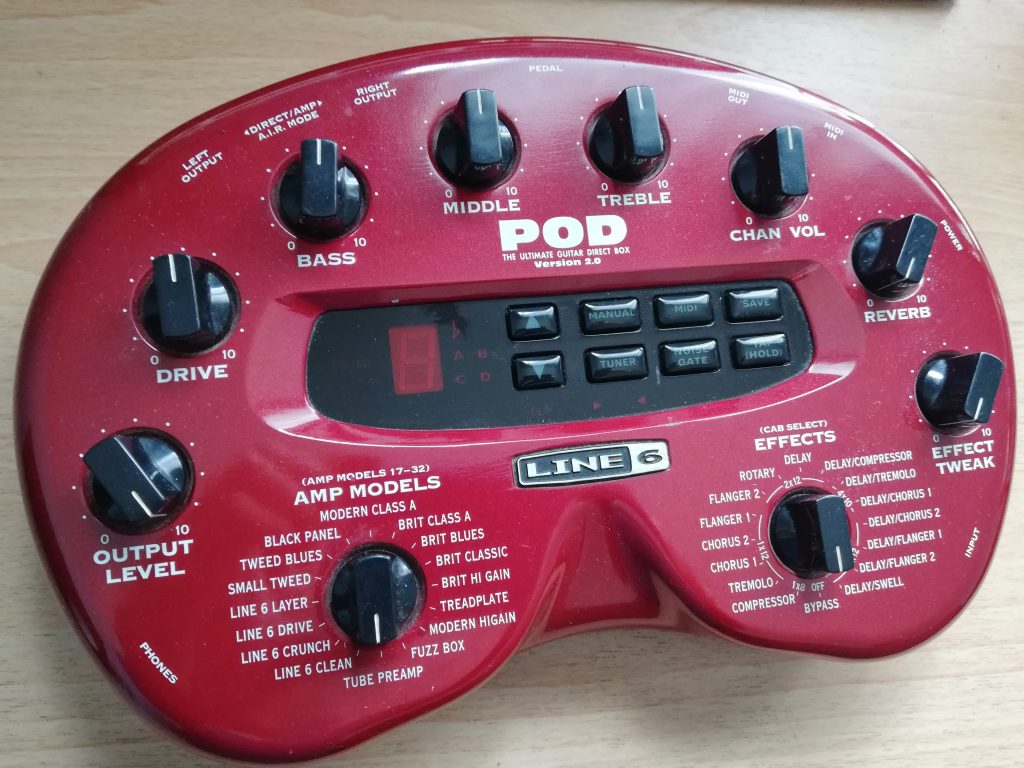Who says old technology is irrelevant? When it comes to guitar effects, you should listen to your ears first and foremost.
Today the Line 6 Pod 2.0 is about 20 years old. I recently picked one up off eBay (about $150) so that I could spend some time with it.
The older Line 6 technology still happens to have a large group of supporters. Some claim to prefer the sound of the older Pod 2.0 over and above newer releases like the Helix.
There are a few species of the Pod. Each sound a little different, or so I’ve read. Here’s a post by user MKB on The Gear Page:
I agree that the Pod is a classic and may even become collectible in the future. Not only because it is a well thought out piece of industrial design, but it got great tones used by big players on famous albums. If the TR808, Apple II and Minimoog can fetch huge sums, so can the early Pods.
I have a small collection of Pods (bought them broken on eBay and fixed them). The Pod 1, Pod 2.0 script logo, and Pod 2.0 block logo (the one that will accept a FBV footswitch) all sound a little different from each other. The overdriven amps in the 1 and 2.0 script are a bit smoother, but the cleans in the 2.0 block are much better. The 2.0 script and 2.0 block are completely different designs, i.e. the 2.0 script has an EEPROM and the 2.0 block has all flash memory.
FWIW, if your 2.0 won’t start up, have your tech download the service manuals (easily found with a Google search). Turns out that some of the 2.0’s had a bad run of chip capacitors, and these can sometimes go bad and lock up the unit. But they are cheap and easily replaced and will get the unit running great again. The service manuals are very good and have a lot of troubleshooting information that will help fix the Pod.
The Pod 2.0 has a quality in the midrange that I personally like a lot. If you’ve seen any of Tim Pierce’s video’s, he refers to this as the “midrange fist.” I’m yet to test out version 1, and some people have claimed to like it even more.
Another plus point is the ease of use. Because the Pod 2.0 is desktop based, I find it very easy to operate in comparison to floor-based processors. Line 6 got it right the first time, and there actually wasn’t much to improve upon.
The knobs have a particularly smooth feeling to them. You can feel the difference in response to each amp model.
At this point, it may sound like I’m biased in favor of the older Pod. But to be honest I’m getting a lot of use out of it. It’s not irrelevant technology either. My personal opinion is that if there’s been any improvement on the Pod technology, it will be very hard to hear. The user manual said it best:
Whether you use your POD as a direct recording miracle, a stomp box on steroids, for practice, or as a creative digital signal processing tool – and heck, why should it be just one? – we think you’ll agree that POD is about the most amazing thing to happen to electric guitar since – well, since the guitar amplifier itself. POD mines the tonal heritage of the past forty years of guitar amplifier design and matches it up with the kind of digital signal processing magic that will still be ahead of its time in the next century.
The Pod 2.0 is perfectly acceptable in a live situation, too. It can plug directly into the mixing desk. If you don’t need to do much effect switching, it may offer an extremely portable solution.
One interesting observation is that Pod 2.0 doesn’t contain a presence control, which was only introduced in later versions of the POD. If you’re feeling adventurous, you can work around this limitation by hooking your POD up to a PC via midi, and use special software to gain access to the presence control. It makes sense, however, that the POD interface doesn’t include this control. It may be that the POD simply sounds optimal with the default setting.
The Pod did end up playing a role in the introduction of latency. Because the signal is processed digitally, there will always be a small delay be the performance and what you’re hearing. Perhaps this has been improved upon in later models like the Pod HD. It’s interesting that when the Pod was first released, a lot of people complained about it. Now it seems that people have adapted to a more digital route, especially considering the popularity of guitar plugins.
Stay tuned on the upcoming post about the Pod X3 Live, the floor-based successor to the older Pod units.


Very interesting read! I’ve had or used a few PODs in my time as a musician, I honestly stopped at the X3 live floorboard (wishing i could source a cheap rack version) but with all the footswitches failing I think it may be time to look backward or forwards. My buddy has been using his POD 2.0 as long as I’ve known him and I can’t convince him to try something else! Looking forward to your article on the X3 floorboard, I use it on all of my recordings.